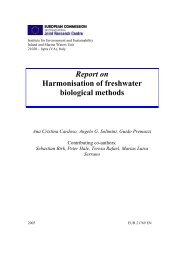Lakes and Watercourses
Lakes and Watercourses
Lakes and Watercourses
You also want an ePaper? Increase the reach of your titles
YUMPU automatically turns print PDFs into web optimized ePapers that Google loves.
Periphyton – diatoms<br />
in watercourses<br />
Introduction<br />
Periphyton algae play an important part as a primary producer, particularly<br />
in running waters. These algae are also a good indicator of water<br />
quality. Analysis of periphyton algae may therefore serve to supplement<br />
or replace chemical or other biological studies. Periphyton algae may be<br />
the only feasible biological indicator in slow-flowing waters.<br />
The assessment is confined to watercourses <strong>and</strong> is based on two<br />
indices, both designed to reflect the degree of eutrophication <strong>and</strong> general<br />
pollution impact.<br />
Assessment of current conditions<br />
TABLE 38.<br />
CURRENT CONDITIONS: index, diatoms<br />
Class Description IPS index or IDG index<br />
1 Very high index figure ≥ 17.5<br />
2 High index figure 14 – 17.5<br />
3 Moderate index figure 10.5 – 14<br />
4 Low index figure 7 – 10.5<br />
5 Very low index figure < 7<br />
The IPS (Indice de polluo-sensibilité) <strong>and</strong> IDG (Indice diatomique<br />
génerique) indices are calculated as:<br />
∑ A i I i V i /∑ A i V i<br />
where Ai is the relative abundance of taxon i, expressed as a percentage,<br />
V i is the indicator value of taxon i (1 – 3) <strong>and</strong> I i is the sensitivity to<br />
pollution of taxon i (1 – 5). The result obtained using the above formula is<br />
converted into a scale of 1 – 20 as follows:<br />
4.75 · original index value –3.75.<br />
63















![Accommodation booking form [PDF]](https://img.yumpu.com/39471785/1/184x260/accommodation-booking-form-pdf.jpg?quality=85)

